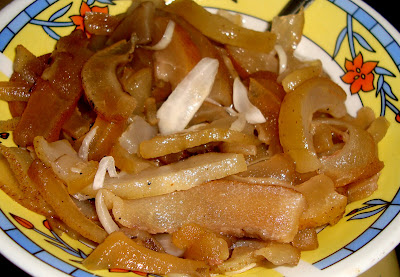Garlic Sprouts, Anyone?
Dr Abe V RotorHusked cloves of garlic sprouted in a refrigerator, 10 to 20 degrees Celsius (vegetables shelf), for a period of two weeks.
Sprouted garlic has higher anti-oxidant properties. This process is cleaner than directly sprouting garlic exposed to sunlight. Ref-sprouted garlic sprouts develop chlorophyll and turn green just after a few hours of indirect sunlight. Conventional garlic sprouts are green, harvested from germinating bulbs. or bulbs raised in the garden or pots. These are popularly called garlic shoots. (Photos taken from actual result of home experiment in the author's residence. Model is Miss Resabel "Isang" Dimalanta, 18.)How to use Garlic Sprouts
Ideally, their flavor is best appreciated eaten fresh. Garlic sprouts are excellent on top of baked potatoes, green salads, vegetable salads, or stirred into egg salads, pasta salads, dips, and as a quick garnish over hummus or guacamole (dips).
 Sprouted garlic on caliente, ox hide.
Sprouted garlic on caliente, ox hide.
Hide is cleaned, and softened under low fire for hours, sliced thinly, spiced heavily with onion and pepper, and salt - and, garlic sprouts
 Add sprouted garlic to kilawen and pinapa-itan. it's simply superb!
Add sprouted garlic to kilawen and pinapa-itan. it's simply superb!
Favorite goat recipes: kilawin (left) or medium rare; and pinapa-itan (soup made of entrails and chyme, which gives the bitter taste. Chyme is extracted from the partially digested grass, and heated to pasteurization temperature, around 70 degrees Celsius. Gall is often used as substitute.)
"Sprouted
garlic enhances raw garlic's proven anti-inflammatory, immune-boosting,
cardiovascular health protection, and its ability to kill 14
types of cancer cells. A sulfur-rich compound in garlic called allicin is
effective against bacteria, viruses, fungi and parasites without toxic side
effects."
- Korea's Institute of Planning and Evaluation for
Technology,
The ACS' Journal of Agricultural and
Food Chemistry
Here are 15 health benefits of garlic:
Dr Anitha AnchanAntibacterial and Antiviral
Garlic is most well-known for its antibacterial and antiviral properties. They help control bacterial, viral, fungal, yeast and worm infections. Fresh garlic is thought to play a role in preventing food poisoning by killing bacteria like E. coli, Salmonella enteritidis, etc. To treat skin infections
The chemical ajoene found in garlic may help treat fungal skin infections like ringworm and athlete’s foot.
Blood thinning
The anti-clotting properties of ajoene found in garlic help in preventing the formation of blood clots in the body. Hence, it may also increase the risk of bleeding after surgery.
Reduce blood pressure
Angiotensin II is a protein that helps our blood vessels contract thereby increasing the blood pressure. Allicin in garlic blocks the activity of angiotensin II and helps in reducing blood pressure. The polysulphides present in garlic are converted into a gas called hydrogen sulphide by the red blood cells. Hydrogen sulphide dilates our blood vessels and helps control blood pressure.
Protect heart
Garlic protects our heart against cardiovascular problems like heart attacks and atherosclerosis. This cardio-protective property can be attributed to various factors. With age, the arteries tend to lose their ability to stretch. Garlic may help reduce this and may also protect the heart from the damaging effects of free oxygen radicals. The sulphur-containing compounds of garlic also prevent our blood vessels from becoming blocked and slow the development of atherosclerosis (hardening of the arteries). The anti-clotting properties of ajoene help prevent clots from forming inside the blood vessels.
Reduce cholesterol
Garlic has the ability to moderately lower our blood triglycerides and total cholesterol and reduce arterial plaque formation.
Combat allergies
Garlic is known to have anti-inflammatory property. It can help the body fight against allergies. The anti-arthritic property of garlic is due to diallyl sulphide and thiacremonone. Garlic has been show to improve allergic airway inflammation (allergic rhinitis). Raw garlic juice may be used to immediately stop the itching due to rashes and bug bites.
Remedy for respiratory problems
Daily use of garlic might reduce the frequency and number of colds. Its antibacterial properties help in treating throat irritations. Garlic may also reduce the severity of upper respiratory tract infections. Its benefits in disorders of the lungs like asthma, difficulty of breathing, etc. make it a priceless medicine. Its ability to promote expectoration makes it irreplaceable in chronic bronchitis.
Diabetes
Garlic increases insulin release and regulates blood sugar levels in diabetics.
Effective against warts and corns
Applying fat dissolving garlic extracts to corns on the feet and warts on the hands is thought to improve these conditions.
Cancer prevention
Daily intake of garlic has been found to lower risk of most types of cancer. This anti-cancer property is due to allyl sulphides found in garlic. PhIP, a type of heterocyclic amine (HCA), has been associated with increased incidence of breast cancer among women. According to studies, diallyl sulphide found in garlic inhibits the transformation of PhIP into carcinogens.
Improve iron metabolism
Ferroportin is a protein which helps in iron absorption and release. Diallyl sulphides in garlic increase production of ferroportin and help improve iron metabolism.
Stir up passions
Garlic’s aphrodisiac property is due to its ability to increase the circulation.
Toothaches
Simply put some crushed garlic clove directly on the affected tooth can help relieve toothaches due to its antibacterial and analgesic properties. But be aware that it can be irritating to the gum.
Reduce weight
Many researchers believe that obesity is a state of long-term low-grade inflammation. According to recent research, garlic may help to regulate the formation of fat cells in our body. Pre-adipocytes are converted into fat cells (adipocytes) through inflammatory system activity. The anti-inflammatory property of 1, 2-DT (1, 2-vinyldithiin) found in garlic may help inhibit this conversion. This may help prevent weight gain.
References: Living with Nature AVR,
ACS' Journal of Agricultural and Food Chemistry, Internet
Lesson on Living with Nature - School on Blog [avrotor.blogspot.com]Paaralang Bayan sa Himpapawid (People's School-on-Air) with Ms Melly C Tenorio
738 DZRB AM, [www.pbs.gov.ph] 8-9 evening class Monday to Friday



No comments:
Post a Comment